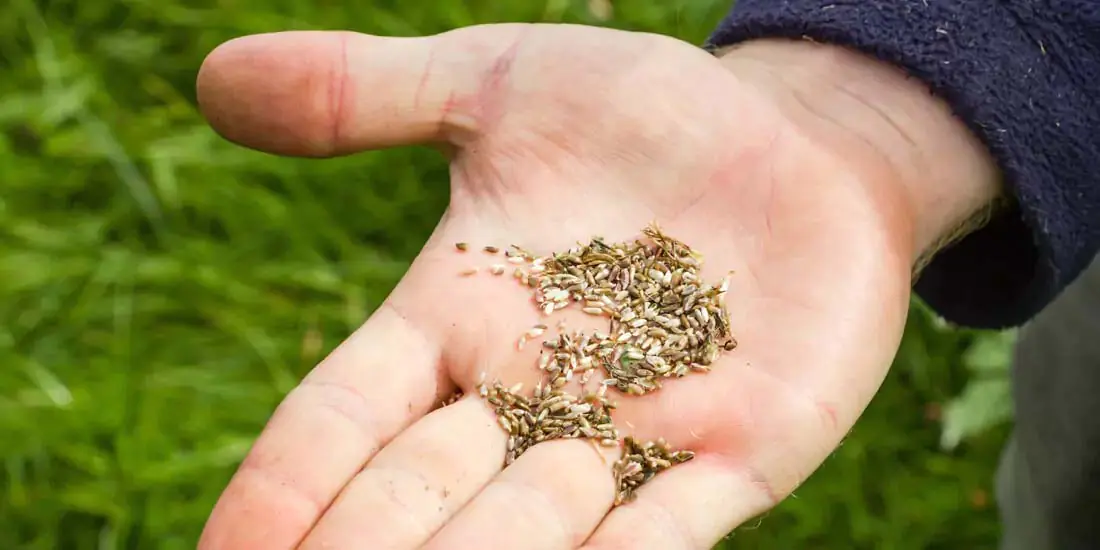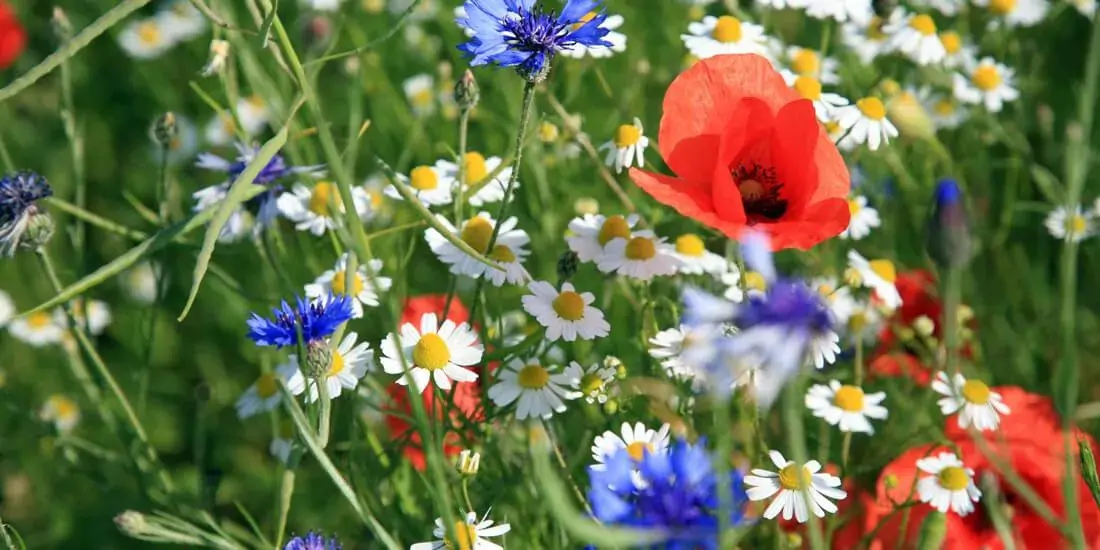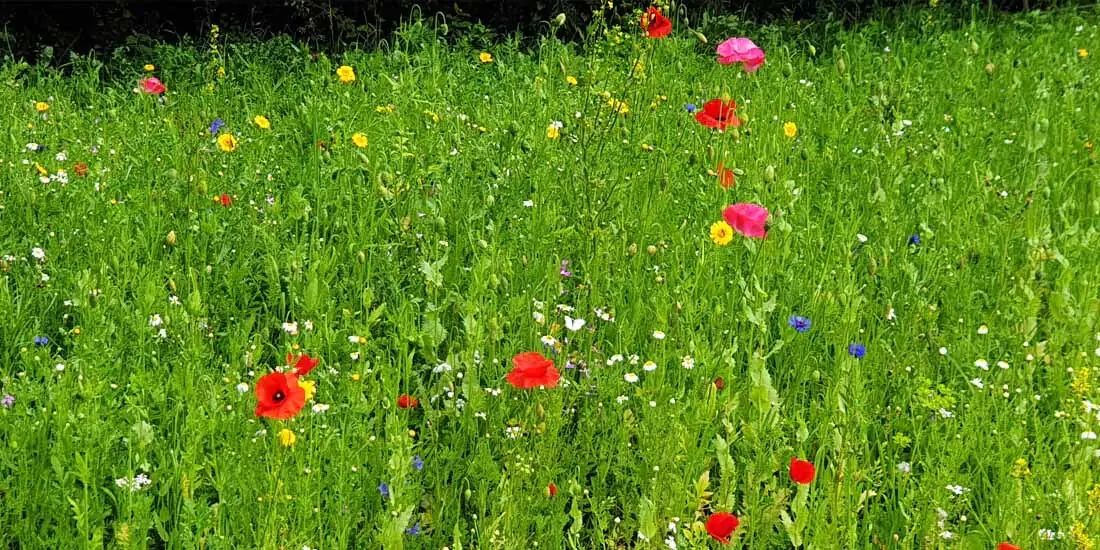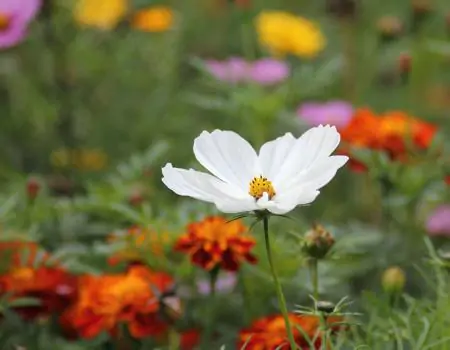Wildflowers FAQs
Learn more about sowing, growing and maintaining a wildflower meadow from our Wildflowers Frequently Asked Questions section.
Getting Started
- Remove any existing grass, plants or flora from the area where you plan to sow your wildflower seed. Failure to do this will produce poor results
- Further remove the top 5-10cm to reduce soil fertility
- Allow the area to cultivate for several weeks, and remove any weeds that may pop in the area during this time
- Do not be tempted to add top soil, compost or fertiliser to the area - wildflowers prefer low nutrient conditions
- After the cultivation period ensure to remove stones or any other debris and rake the area to create a fine, friable and level seedbed
- Scatter the seed at a rate of 5g per m2
- Rake the seed so that it is in amongst the soil
- Water the just-sown wildflower seed well
- If sowing in drought conditions, water as required to keep the area moist in the first 6 weeks after sowing
Sowing wildflowers into an existing lawn is a futile exercise and will produce poor results. Lawn grasses are much more fertile and vigorous than wildflowers and they will stunt the germination, growth and establishment of wildflowers. For best results, remove any existing grass, weeds or flora in the area where you plan to sow wildflowers.
Autumn and spring are great times to sow wildflower seed. Annuals will appear 60-80 days after sowing, perennials will have a small showing but will take up to one year to fully establish. If you sow in Autumn, you should expect a showing in early spring and if sowing in spring you should see blooms in summer.
If you consider your soil type to be normal and the area where you plan to sow your wildflower seed relatively free from shade, you can sow our Bees & Pollinators, Flowering Meadow, or SIMPLY: Wildflowers mix. For a large area, we recommend opting for a mix that contains grass. If you plan to sow a border or bed, we would recommend a 100% wildflowers mix such as our Annuals or Meadow Magic.
However, if you have clay soils, sandy soils, or the area is heavily shaded, you may benefit from our more specialised mixes.
If you want to turn a large field into a meadow over time, you should consider introducing Yellow Rattle.
If your chosen wildflower mix contains grass, your grass will germinate when tempereatures are 8-10 degrees and above consistently for two weeks. Following this, annuals will bloom 60-80 days later and perennials will take up to 1 year to establish.
Annuals typically have one showing (period of blooms) and will bloom 60-80 days after being sown. Perennials will return year after year and have multiple showings (blooms year on year).
Mowing and Maintenance
Wildflowers are known for their low maintenance, but in the early stages they do require some watering to keep the area moist. After sowing, water your just-sown wildflower seeds. In the first six weeks after sowing, make sure to keep your growing wildflower seeds moist by watering twice a week if there is no rainfall.
If you've sown your wildflower seed in April / May (spring)
In August / September of the first year you have sown your wildflower seed, cut your wildflower sward to 7cm after flowering – you can do this by putting your mower on a high setting. In most cases remove clippings* (Note: a late spring sowing will result in late flowering). Do not be tempted to fertilise or add top soil to this area – wildflowers prefer poor soil conditions, and this is how they should stay. Continue this same process, year after year. *If you have annual wildflowers in your mix and you do not wish them to return the following year, remove the clippings. If you want your wildflowers to return the following year - let them go to seed head, and manually assist their self-seeding by firming the seed heads into the soil. By doing this, your annuals will return the following year.
If you've sown your wildflower seed in September / October (autumn)
In March / April of the first year of sowing your wildflower seed, make sure there is sufficient material to mow – your wildflowers / grasses should be at a height of 10cm. If your wildflowers are at this height, mow to 7cm no later than mid-April, to help encourage perennial species to spread. In August / September, after they have bloomed, cut your wildflower meadow again to 7cm, remove all clippings unless you want your annuals to return. If you want your wildflowers to return the following year - let them go to seed head, and manually assist their self-seeding by firming the seed heads into the soil. By doing this, your annuals will return the following year.
Yes, consider it
When sowing wildflowers, we always recommend that you try to clear the area where you plan to sow them as best you can. This means – no grass, no weeds and no other flora. For small areas, this is easy enough to achieve. With larger arable fields this is a huge task to undertake and still may be fruitless. In this instance, yellow rattle is a great addition to your meadow to weaken the grasses and allow you to introduce other wildflowers without the threat of them being overtaken.
No, not necessary
Yellow Rattle works well in existing meadows or in large areas that are mainly grass where complete removal of grasses and weeds would be difficult. If you are sowing a wildflower meadow from scratch, however, you may not need Yellow Rattle. Once you have cleared the area where you wish to sow, you can sow a grass and wildflower seed mix that, when sown at once, will eradicate the issue of grasses or weeds taking over.
Cut your grass as short as possible at the end of summer and scarify (rake) the area aiming for 50% bare soil. Sow your Yellow Rattle before winter sets in (do not leave sowing any later than November) – it will germinate and bloom in early spring and begin to weaken the existing grasses. At which point you can then consider introducing new wildflower seeds by scarifying the area and sowing.
Yes, you can add more wildflowers to your meadow year on year. It's important when introducing new wildflower seeds that you do it at the correct time of year. We would recommend doing this in spring or autumn when your meadow has been mown. You should scarify the area to achieve bare soil to sow your new wildflower seed.
Annuals typically only have one showing but you can see them again the following year – if you do your prep. Annuals go to seed head each autumn and drop seeds into the soil. They are self-seeding, and almost self-sufficient but unfortunately, their process is not perfect – they need a bit of a helping hand. You can manually assist this process by putting your mower on a high setting or cutting the wildflowers down. Then use a roller (if you’re fancy!) or your wellies to split the seed heads up to allow more seeds to get into the soil. This will result in an annual showing in the following year.
About Our Seed
Whilst they may have Latin names, our wildflower seeds are 100% UK native and are harvested in England. They are grown here, sown here, and bloom for many years to come. We believe it's important to preserve and restore our local and national biodiversity, and we can only do that by reinstating what existed before, our native and naturally-occurring wildflowers. Whether its an annuals mix, an annuals and perennials mix or an annuals and perennials mix with grass, our wildflower seeds are, and will always be 100% UK native.
The majority of our wildflower mixes contain grasses alongside wildflower seed. When sown at the same time, the grass will shoot up first to create a nursery for the wildflowers. This stops weeds from taking over and allows the wildflowers to take root.
If there was a definitive guide to sowing wildflower seeds, most experts would recommend sowing wildflowers in autumn as typically the seeds need to undergo the process of stratification (a freeze) to kick start their germination. At The Grass People, we keep our seeds in cold conditions all year round so you can sow them in spring too. Delaying from September / October, April / May recommended sowing times shouldn’t greatly affect your wildflower meadow, but it is advisable to avoid sowing in winter.
No, your wildflower meadow will not look the same year on year. There are a number of factors that will influence how your meadow will appear including soil conditions, weather conditions and the space your wildflowers will have to grow. Some wildflower species will thrive in the conditions you provide them with and others may not. After all, they are wild things and make their own rules!
Our wildflowers typically grow to heights of 1 - 2ft. If you sow our wildflowers on particularly fertile soil (which is not advisable) they may grow taller than this.
All of the wildflowers in our mixes are listed on the RHS Plants for Pollinators recommended list for their ability to attract bees and other pollinators. On the list, you can find the common name for the wildflower species alongside their Latin names. Aside from featuring pollinator-attracting wildflowers in our mixes, we also work with the Bumblebee Conservation Trust through our business membership.
The safeness and suitability of sowing wildflowers in reach of children and pets largely concerns whether consumption / ingestion of the flowers is of a huge concern.
Wildflowers such as Buttercups and Foxgloves are poisonous to animals and can be to humans, and are present in all of our wildflower mixes. Each of these wildflowers have minor to moderate toxicity and can prove fatal if consumed / ingested in any amount. Therefore, we would not recommend sowing any of our wildflower seed mixes, or any others, near your children or pets if you have concerns that they would consume them.
Animals have intelligent instincts and by using their scent can work out what is and what isn’t poisonous, so there is low risk of them wanting to snack on your wildflowers. However, if your pet or livestock has a penchant for wolfing down wildflowers or any other garden flora it’s best not to put anything in front of them that could potentially harm them.
Likewise, children may have the same curiosity. If you are concerned that your child may try to eat the wildflowers in your garden, then again, we would advise not sowing them.




